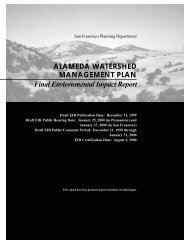Feasibility of Fish Passage at Alameda Creek Diversion Dam
Feasibility of Fish Passage at Alameda Creek Diversion Dam
Feasibility of Fish Passage at Alameda Creek Diversion Dam
Create successful ePaper yourself
Turn your PDF publications into a flip-book with our unique Google optimized e-Paper software.
6.0 Additional Consider<strong>at</strong>ions and AnalysisFor purposes <strong>of</strong> this technical memorandum, a sustainable steelhead popul<strong>at</strong>ion in the Upper <strong>Alameda</strong><strong>Creek</strong> Basin is defined as having both a positive spawner replacement r<strong>at</strong>io and a minimum viablepopul<strong>at</strong>ion size. The spawner replacement r<strong>at</strong>io is an estim<strong>at</strong>ion <strong>of</strong> the number <strong>of</strong> adult progeny th<strong>at</strong>successfully return and spawn compared to the number <strong>of</strong> spawners th<strong>at</strong> were used to cre<strong>at</strong>e them. Ifmore adult fish return in subsequent gener<strong>at</strong>ions than were used to cre<strong>at</strong>e them, then the replacementr<strong>at</strong>io is positive, and allowing fish passage has contributed to an overall increase in the popul<strong>at</strong>ion. Ifadult returns are smaller than the popul<strong>at</strong>ion used to cre<strong>at</strong>e them, there is a net neg<strong>at</strong>ive effect on thepopul<strong>at</strong>ion and a neg<strong>at</strong>ive contribution to overall basin production. When the replacement r<strong>at</strong>io is1:1, the popul<strong>at</strong>ion is in equilibrium. Spawner replacement r<strong>at</strong>io is expected to vary from year to yearbased on various life stage survival r<strong>at</strong>es. For example, exceptionally dry years could neg<strong>at</strong>ivelyimpact juvenile survival and El Nino events would be expected to decrease ocean survival. Similarly,wet years could enhance juvenile survival and the ability for adults to successfully immigr<strong>at</strong>e.Nevertheless, when averaged across years, a positive long-term spawner replacement r<strong>at</strong>io would berequired for success.In addition to n<strong>at</strong>ural fluctu<strong>at</strong>ions in productivity <strong>of</strong> the popul<strong>at</strong>ion, as described above, potentialreductions in fish production are also associ<strong>at</strong>ed with fish passage components. These reductions inproductivity may result from reduced capture efficiencies or increased stress-rel<strong>at</strong>ed mortalitiesassoci<strong>at</strong>ed with the handling and transport <strong>of</strong> fish.NMFS policy regarding recovery <strong>of</strong> listed anadromous salmonids requires use <strong>of</strong> the concept <strong>of</strong>Viable Salmonid Popul<strong>at</strong>ion (VSP), which requires establishment <strong>of</strong> abundance and productivitygoals, including a long-term spawner replacement r<strong>at</strong>io <strong>of</strong> <strong>at</strong> least 1:1, as well as a minimum viablepopul<strong>at</strong>ion size (NMFS, 2000 and 2008b). Shaffer (1981) st<strong>at</strong>es “a minimum viable popul<strong>at</strong>ion forany given species in any given habit<strong>at</strong> is the smallest isol<strong>at</strong>ed popul<strong>at</strong>ion having a 99 percent chance<strong>of</strong> remaining extant for 1,000 years despite the foreseeable effects <strong>of</strong> demographic, environmental,and genetic stochasticity, and n<strong>at</strong>ural c<strong>at</strong>astrophes.” A review <strong>of</strong> the fisheries liter<strong>at</strong>ure suggests th<strong>at</strong> aminimum viable popul<strong>at</strong>ion size for Pacific salmon, including steelhead, is comprised <strong>of</strong> <strong>at</strong> least 100breeding pairs. Emlen (1993) reports th<strong>at</strong> a complete run failure for Chinook salmon occurs when thepopul<strong>at</strong>ion falls below 100 breeding females. A self-sustaining popul<strong>at</strong>ion <strong>of</strong> rainbow trout in areservoir system in British Columbia is being cre<strong>at</strong>ed with a “seed” <strong>of</strong> 100 spawning pairs <strong>of</strong> fish,based on a liter<strong>at</strong>ure review <strong>of</strong> rainbow trout popul<strong>at</strong>ions by Langston and Zemlak (1998).Facilit<strong>at</strong>ing fish passage <strong>at</strong> the ACDD could potentially produce a minimum viable popul<strong>at</strong>ion <strong>of</strong> 100spawning pairs if sufficient adult spawning and juvenile rearing habit<strong>at</strong> is available to accommod<strong>at</strong>ethese fish (see Appendix C for details <strong>of</strong> this estim<strong>at</strong>e).The quantity and quality <strong>of</strong> steelhead habit<strong>at</strong> available upstream <strong>of</strong> the ACDD have not beendetermined. Due to the intermittent hydrology <strong>of</strong> <strong>Alameda</strong> <strong>Creek</strong> above ACDD, future steelheadnumbers above ACDD may be more limited by rearing habit<strong>at</strong> than by spawning habit<strong>at</strong>. Based onlimited ground surveys, topographical maps, and aerial photography, it is estim<strong>at</strong>ed here th<strong>at</strong>approxim<strong>at</strong>ely 4 miles (Entrix, 2003) to 10 miles (assuming an extremely wet year and suitable habit<strong>at</strong>is present in some portion <strong>of</strong> the un-surveyed tributaries <strong>of</strong> <strong>Alameda</strong> <strong>Creek</strong> above ACDD) <strong>of</strong> potentialrearing habit<strong>at</strong> is available (see Section 6.1). For the purposes <strong>of</strong> this preliminary analysis it isestim<strong>at</strong>ed th<strong>at</strong> there are between 4 and 10 miles <strong>of</strong> potential steelhead habit<strong>at</strong> (spawning and rearinghabit<strong>at</strong>) above ACDD.The number <strong>of</strong> steelhead th<strong>at</strong> may be expected to spawn in the 4 to 10 miles <strong>of</strong> steelhead habit<strong>at</strong>potentially available above ACDD was approxim<strong>at</strong>ed by evalu<strong>at</strong>ing the spawning densities in placeswhere more extensive surveys have been conducted. Lagunitas <strong>Creek</strong> in Marin County provideshigh-quality habit<strong>at</strong> for salmonids in the San Francisco Bay area. For the past 12 years, salmon andsteelhead spawning surveys have been conducted in the Lagunitas <strong>Creek</strong> w<strong>at</strong>ershed, which containsACDD <strong>Passage</strong> June 2009 Page 6-5








